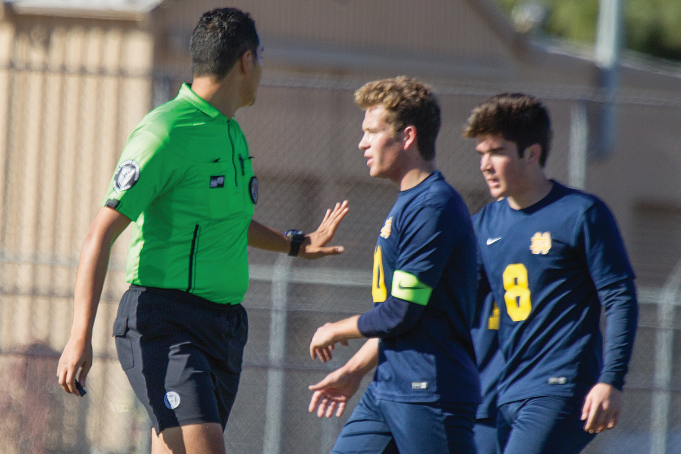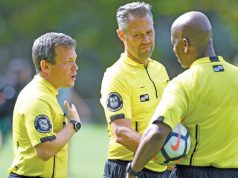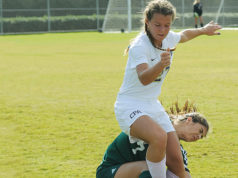Once a referee reaches the point where he/she knows the Laws of the Game well and has learned effective mechanics, what comes next to improve his/her game and advance his/her career? There is more to refereeing soccer at a higher level than just running around calling fouls and the ball out of bounds. Effective game control becomes the next level of expertise to master. This is an especially important skill for the referee in upper-level youth, high school, NCAA, adult amateur and professional play.
But what does “reading” mean? How does a referee read the game to gain better control?
One factor the referee should realize early on in a game is what kinds of tactics are the teams using? Does one team use a slow build-up depending on using many short passes to advance? Are the opponents using quick counter-attacks with long passes to advance? Cautioning players committing fouls to break up promising attacks may be necessary to take this problem out of the game. The referee must differentiate careless fouls between two players in a specific moment and tactical fouls that are part of a coordinated effort to neutralize the other team’s style of play. Some tactical fouls may be subtle or dramatic. When fouls have a purpose there is a meaning that the referee must identify and punish to show the teams they must not continue.
One team may be using an aggressive offside trap to neutralize the other team’s attack. While this is certainly within the laws when executed properly, the officiating team must be working together well to make sure it does not miss a properly executed offside trap. On the other hand, if the defensive team’s trap is not effective, the officials have to let play continue through the failed trap and deal with the ensuing frustration by the defense.
The referee will have to identify troublemakers on either team and be prepared to watch them closely to deal with them. Opponents may get fed up with one of these players and retaliate. A quiet word with these troublemakers can be effective as a warning displaying that the referee understands what is going on and is fully prepared to shut down misconduct. Other verbal methods including humor may influence troublemakers to change their ways once they realize the referee is on to them.
If a player commits persistent fouls, the referee must warn and/ or caution the player involved to stop the pattern. Counting fouls is necessary to identify persistent infringement. While the laws do not state specifically how many fouls by a player are considered persistent, it is up to the referee to decide this within the context of each game using his or her own best judgment. Sometimes the “density” of fouls within a space of time or in relationship to a previous event (a goal, a sendoff, or a penalty kick) will also precipitate more fouls. Letting players know that a pattern of troublesome events will be addressed sends them the message that the referee understands what is in progress.
One team may have a particularly skilled goal scorer who is adept at eluding defenders. Watch challenges closely when this player is involved. Does a pattern of fouls against this player by several members of the opposing team develop? Repeatedly fouling the same player by several members of the other team may also be a pattern of unsportsmanlike conduct.
Watch for player matchups where there is a mismatch of skills. A less-skilled defender may resort to fouling his opponent to prevent a promising goal-scoring opportunity. If the less-skilled player is on attack in possession of the ball, the referee could be prepared for simulation of a foul. Observing this early in the game and realizing the potential for foul play should prepare the referee to warn or caution.
Based on how the game is being played tactically, the referee needs to anticipate what may happen, and be prepared and in position for the next event to be close to the play. This can be especially challenging if it involves a lot of sprinting. The referee must be up to the challenge both fitness-wise and positioning-wise. Just being a “reactor” may not be enough for effective game control.
Game events like tying goals or a go-ahead goal in the last few minutes will “amp” up the intensity of the game suddenly. A referee who realizes this will react accordingly and keep the game under control. Staying closer to the play, lending a presence or tightening up the type of fouls called may be necessary. Players will be playing harder to score another goal and the higher intensity may result in more fouls and possibly misconduct.
Listening to the players during the game and watching facial expressions or other body language can help the referee understand what frustrations may be mounting and what to watch for next. This becomes more important if there are angry exchanges between opponents. Identifying these exchanges and expecting possible trouble is another form of anticipation.
When the players feel the referee has an understanding of how the game is being played and is dealing with important events appropriately, they will develop confidence in the officiating and settle down and concentrate on playing the game.
The referee’s job is more complex at these levels and “reading the game” will pay important dividends for a referee’s career as well as for the game.
Ken Wikle, Howell Mich., is a Referee contributor and an instructor in Michigan.
What's Your Call? Leave a Comment:
Note: This article is archival in nature. Rules, interpretations, mechanics, philosophies and other information may or may not be correct for the current year.
This article is the copyright of ©Referee Enterprises, Inc., and may not be republished in whole or in part online, in print or in any capacity without expressed written permission from Referee. The article is made available for educational use by individuals.


















